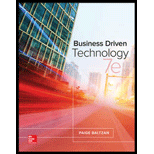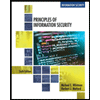
BUSINESS DRIVEN TECHNOLOGY(LL)-W/ACCESS
7th Edition
ISBN: 9781260149043
Author: BALTZAN
Publisher: MCGRAW-HILL HIGHER EDUCATION
expand_more
expand_more
format_list_bulleted
Question
Chapter 17, Problem 2OC
Program Plan Intro
Systems development life cycle (SDLC):
- The seven phases in SDLC includes:
- Planning phase:
- The planning phase includes creating a goal statement for project.
- It defines a high level plan for intended project.
- It sets the scope of project.
- The project plan denotes a formal, approved document that would manage and control entire project.
- A project manager creates a project plan and ensures that project finishes within given deadline and budget.
- Analysis Phase:
- In analysis phase the firm would analyze business requirements.
- It refines goals of project into defined operations and functions of intended systems.
- The business requirements denote specific business requests made by system so as to successfully complete project.
- The requirements management denotes process of managing changes to requirements in business.
- A requirements definition document would prioritize all business requirements based on importance order.
- Design phase:
- The design phase creates description for system features and operations.
- It includes following items:
- Screen layout
- Business rules
- Process diagrams
- Pseudo code
- The graphical user interface (GUI) denotes an
information system interface.
- Development phase:
- The development phase transforms detailed design documents into actual system.
- During this phase, the team defines
programming language for development. - A scripting language may provide interactive modules to website.
- Object oriented languages may group data into objects.
- Testing phase:
- The testing phase keeps all project modules under testing environment for elimination of bugs and errors.
- It verifies that system meets all requirements mentioned in analysis phase.
- Bugs denote defects in information system code.
- The test conditions denote steps that must be performed and expected result for each step.
- Implementation phase:
- The system is placed into production, detailed documentation is performed.
- The users begin actual operations in business within system.
- Maintenance phase:
- The organization performs corrections, changes and up gradations to ensure that system meets requirements.
- Corrective maintenance would make system changes to flaws in design, errors in coding or issues in implementation.
- Preventive maintenance would make system changes to reduce chances for system failure in future.
- Planning phase:
Expert Solution & Answer
Want to see the full answer?
Check out a sample textbook solution
Students have asked these similar questions
Create a static function in C# where poachers appear and attempt to hunt animals. It gets the location of the closest animal to itself. Take account of that the animal also move too, so it should update the closest location (x, y) everytime it moves to a new location. Use winforms to show the movements of poachers.
Create a static function in C# where poachers appear and attempt to hunt animals. It gets the location of the closest animal to itself. Take account of that the animal also moves too, so it should update the closest location (x, y) everytime it moves to a new location. Use winforms to show to movements
I have to develop an efficient parallel numerical integration program on a 2-D mesh but I'm struggling. And it has to be in Cstar
Chapter 17 Solutions
BUSINESS DRIVEN TECHNOLOGY(LL)-W/ACCESS
Knowledge Booster
Similar questions
- An employee is departing from the company you work for. Explain why it could be best practice not to delete their user account but to lock it instead.arrow_forwardthe nagle algorithm, built into most tcp implementations, requires the sender to hold a partial segment's worth of data (even if pushed) until either a full segment accumulates or the most recent outstanding ack arrives. (a) suppose the letters abcdefghi are sent, one per second, over a tcp connection with an rtt of 4.1 seconds. draw a timeline indicating when each packet is sent and what it contains.arrow_forwardJust need some assistance with number 3 please, in C#arrow_forward
- How do we find the possible final values of variable x in the following program. Int x=0; sem s1=1, s2 =0; CO P(s2); P(s1); x=x*2; V(s1); // P(s1); x=x*x; V(s1); // P(s1); x=x+3; V(s2); V(s1); Ocarrow_forwardLab 07: Java Graphics (Bonus lab) In this lab, we'll be practicing what we learned about GUIs, and Mouse events. You will need to implement the following: ➤ A GUI with a drawing panel. We can click in this panel, and you will capture those clicks as a Point (see java.awt.Point) in a PointCollection class (you need to build this). о The points need to be represented by circles. Below the drawing panel, you will need 5 buttons: о An input button to register your mouse to the drawing panel. ○ о о A show button to paint the points in your collection on the drawing panel. A button to shift all the points to the left by 50 pixels. The x position of the points is not allowed to go below zero. Another button to shift all the points to the right 50 pixels. The x position of the points cannot go further than the You can implement this GUI in any way you choose. I suggest using the BorderLayout for a panel containing the buttons, and a GridLayout to hold the drawing panel and button panels.…arrow_forwardIf a UDP datagram is sent from host A, port P to host B, port Q, but at host B there is no process listening to port Q, then B is to send back an ICMP Port Unreachable message to A. Like all ICMP messages, this is addressed to A as a whole, not to port P on A. (a) Give an example of when an application might want to receive such ICMP messages. (b) Find out what an application has to do, on the operating system of your choice, to receive such messages. (c) Why might it not be a good idea to send such messages directly back to the originating port P on A?arrow_forward
- Discuss how business intelligence and data visualization work together to help decision-makers and data users. Provide 2 specific use cases.arrow_forwardThis week we will be building a regression model conceptually for our discussion assignment. Consider your current workplace (or previous/future workplace if not currently working) and answer the following set of questions. Expand where needed to help others understand your thinking: What is the most important factor (variable) that needs to be predicted accurately at work? Why? Justify its selection as your dependent variable.arrow_forwardAccording to best practices, you should always make a copy of a config file and add a date to filename before editing? Explain why this should be done and what could be the pitfalls of not doing it.arrow_forward
- In completing this report, you may be required to rely heavily on principles relevant, for example, the Work System, Managerial and Functional Levels, Information and International Systems, and Security. apply Problem Solving Techniques (Think Outside The Box) when completing. should reflect relevance, clarity, and organisation based on research. Your research must be demonstrated by Details from the scenario to support your analysis, Theories from your readings, Three or more scholarly references are required from books, UWIlinc, etc, in-text or narrated citations of at least four (4) references. “Implementation of an Integrated Inventory Management System at Green Fields Manufacturing” Green Fields Manufacturing is a mid-sized company specialising in eco-friendly home and garden products. In recent years, growing demand has exposed the limitations of their fragmented processes and outdated systems. Different departments manage production schedules, raw material requirements, and…arrow_forward1. Create a Book record that implements the Comparable interface, comparing the Book objects by year - title: String > - author: String - year: int Book + compareTo(other Book: Book): int + toString(): String Submit your source code on Canvas (Copy your code to text box or upload.java file) > Comparable 2. Create a main method in Book record. 1) In the main method, create an array of 2 objects of Book with your choice of title, author, and year. 2) Sort the array by year 3) Print the object. Override the toString in Book to match the example output: @Javadoc Declaration Console X Properties Book [Java Application] /Users/kuan/.p2/pool/plugins/org.eclipse.justj.openjdk.hotspo [Book: year=1901, Book: year=2010]arrow_forwardQ5-The efficiency of a 200 KVA, single phase transformer is 98% when operating at full load 0.8 lagging p.f. the iron losses in the transformer is 2000 watt. Calculate the i) Full load copper losses ii) half load copper losses and efficiency at half load. Ans: 1265.306 watt, 97.186%arrow_forward
arrow_back_ios
SEE MORE QUESTIONS
arrow_forward_ios
Recommended textbooks for you
 Principles of Information Systems (MindTap Course...Computer ScienceISBN:9781285867168Author:Ralph Stair, George ReynoldsPublisher:Cengage Learning
Principles of Information Systems (MindTap Course...Computer ScienceISBN:9781285867168Author:Ralph Stair, George ReynoldsPublisher:Cengage Learning Principles of Information Systems (MindTap Course...Computer ScienceISBN:9781305971776Author:Ralph Stair, George ReynoldsPublisher:Cengage Learning
Principles of Information Systems (MindTap Course...Computer ScienceISBN:9781305971776Author:Ralph Stair, George ReynoldsPublisher:Cengage Learning Enhanced Discovering Computers 2017 (Shelly Cashm...Computer ScienceISBN:9781305657458Author:Misty E. Vermaat, Susan L. Sebok, Steven M. Freund, Mark Frydenberg, Jennifer T. CampbellPublisher:Cengage Learning
Enhanced Discovering Computers 2017 (Shelly Cashm...Computer ScienceISBN:9781305657458Author:Misty E. Vermaat, Susan L. Sebok, Steven M. Freund, Mark Frydenberg, Jennifer T. CampbellPublisher:Cengage Learning Principles of Information Security (MindTap Cours...Computer ScienceISBN:9781337102063Author:Michael E. Whitman, Herbert J. MattordPublisher:Cengage Learning
Principles of Information Security (MindTap Cours...Computer ScienceISBN:9781337102063Author:Michael E. Whitman, Herbert J. MattordPublisher:Cengage Learning C++ for Engineers and ScientistsComputer ScienceISBN:9781133187844Author:Bronson, Gary J.Publisher:Course Technology PtrCOMPREHENSIVE MICROSOFT OFFICE 365 EXCEComputer ScienceISBN:9780357392676Author:FREUND, StevenPublisher:CENGAGE L
C++ for Engineers and ScientistsComputer ScienceISBN:9781133187844Author:Bronson, Gary J.Publisher:Course Technology PtrCOMPREHENSIVE MICROSOFT OFFICE 365 EXCEComputer ScienceISBN:9780357392676Author:FREUND, StevenPublisher:CENGAGE L

Principles of Information Systems (MindTap Course...
Computer Science
ISBN:9781285867168
Author:Ralph Stair, George Reynolds
Publisher:Cengage Learning

Principles of Information Systems (MindTap Course...
Computer Science
ISBN:9781305971776
Author:Ralph Stair, George Reynolds
Publisher:Cengage Learning

Enhanced Discovering Computers 2017 (Shelly Cashm...
Computer Science
ISBN:9781305657458
Author:Misty E. Vermaat, Susan L. Sebok, Steven M. Freund, Mark Frydenberg, Jennifer T. Campbell
Publisher:Cengage Learning

Principles of Information Security (MindTap Cours...
Computer Science
ISBN:9781337102063
Author:Michael E. Whitman, Herbert J. Mattord
Publisher:Cengage Learning

C++ for Engineers and Scientists
Computer Science
ISBN:9781133187844
Author:Bronson, Gary J.
Publisher:Course Technology Ptr

COMPREHENSIVE MICROSOFT OFFICE 365 EXCE
Computer Science
ISBN:9780357392676
Author:FREUND, Steven
Publisher:CENGAGE L